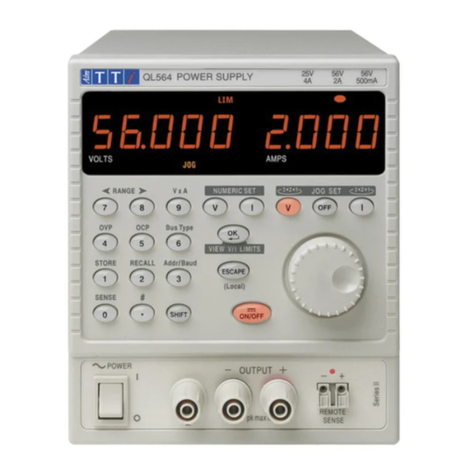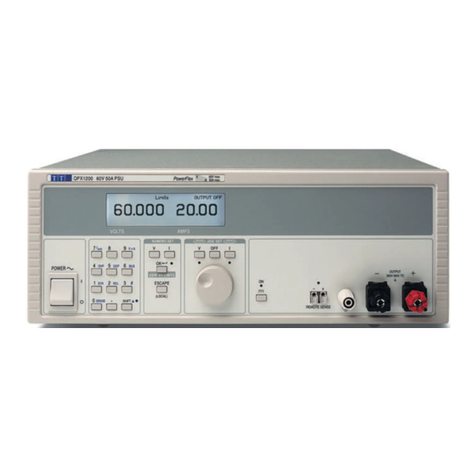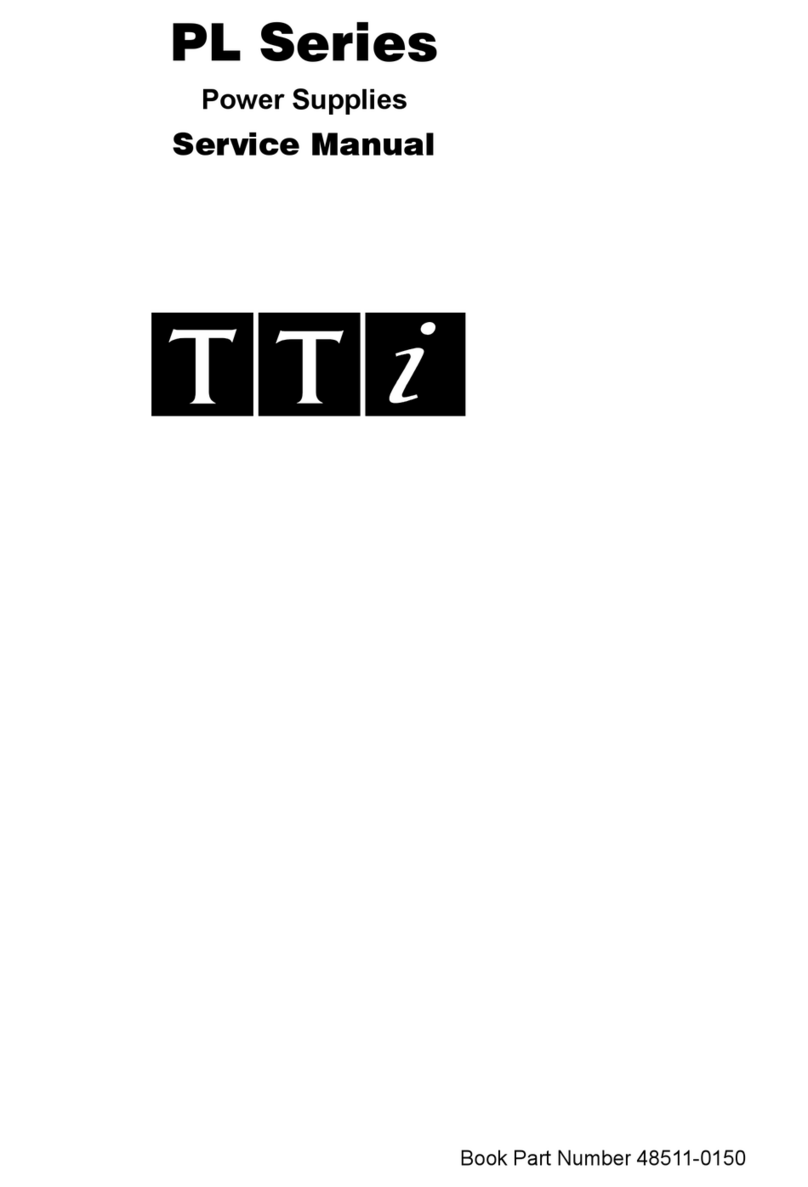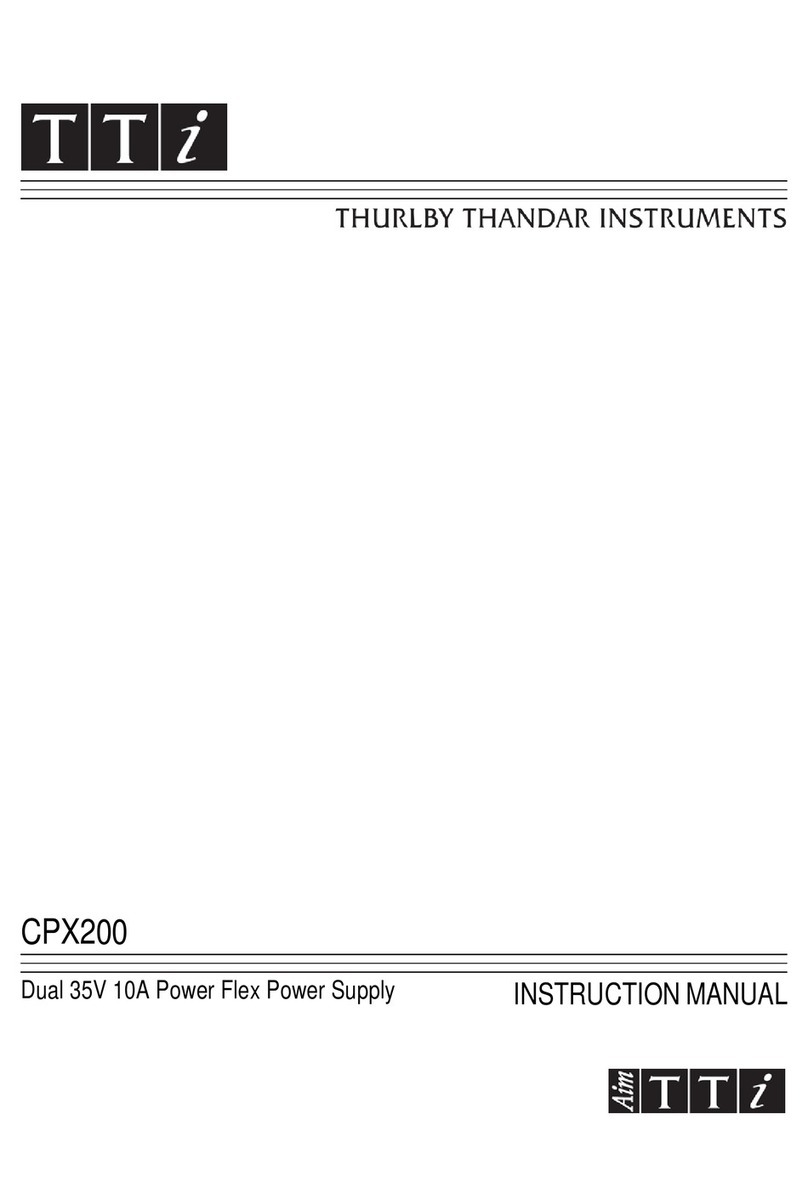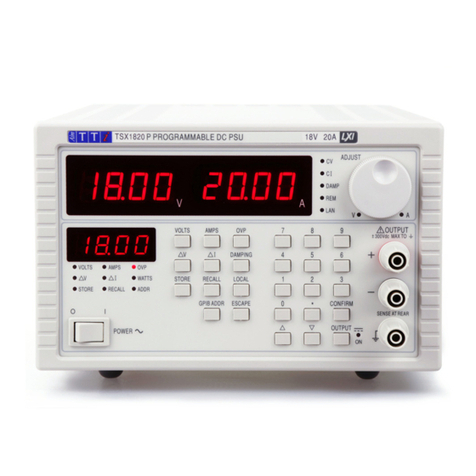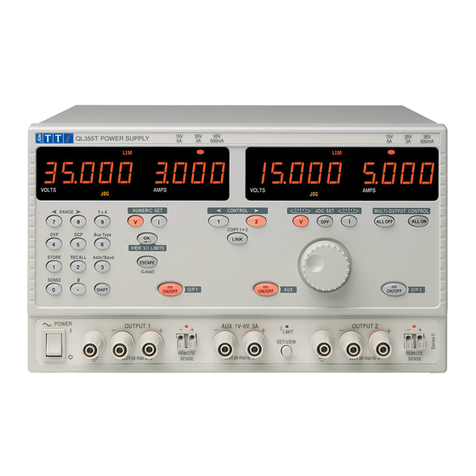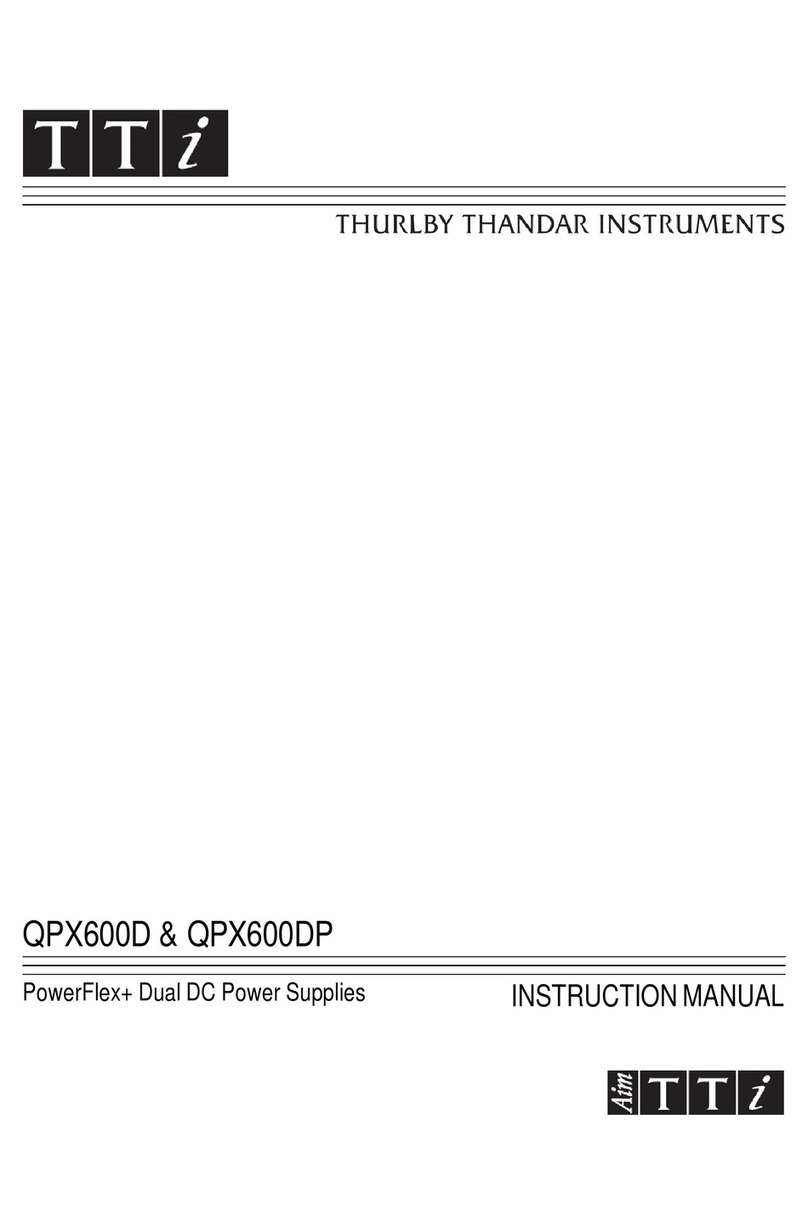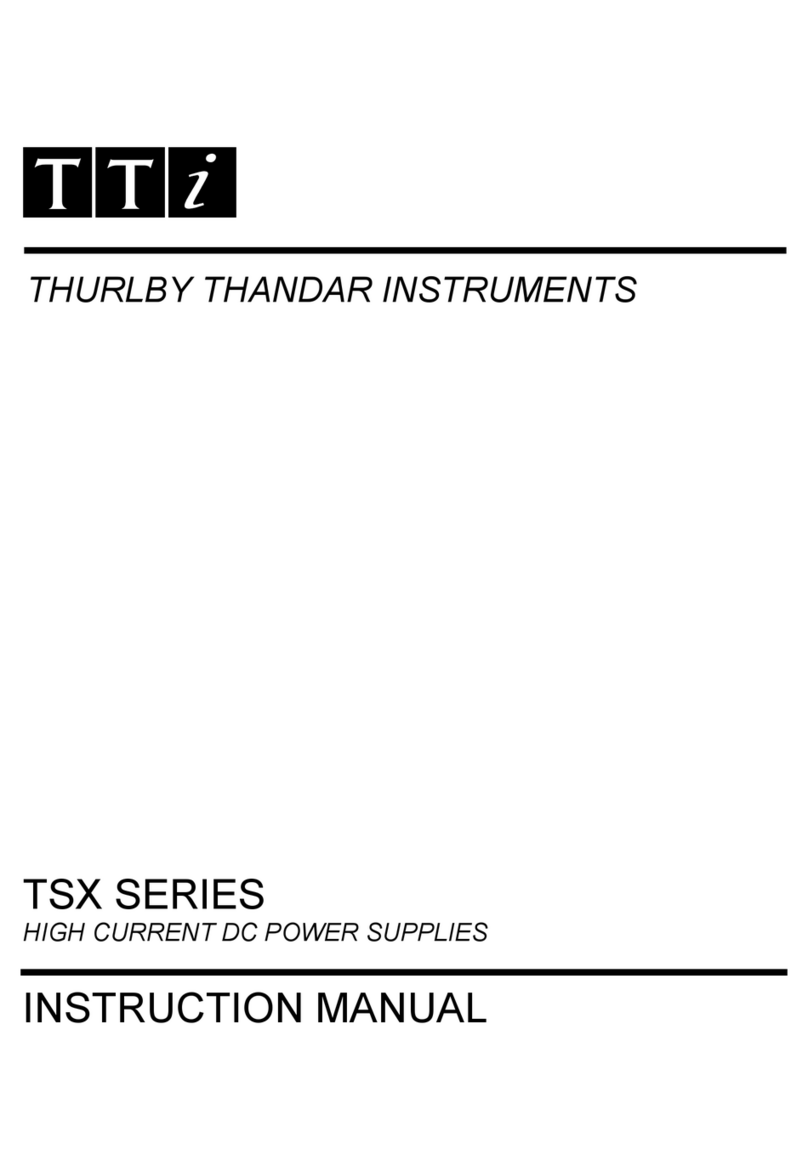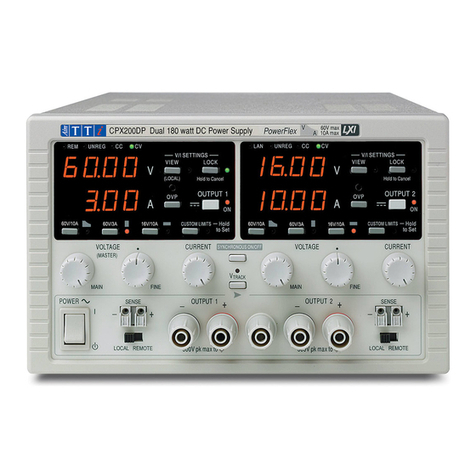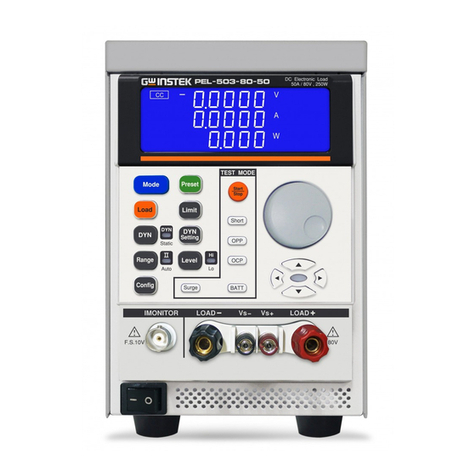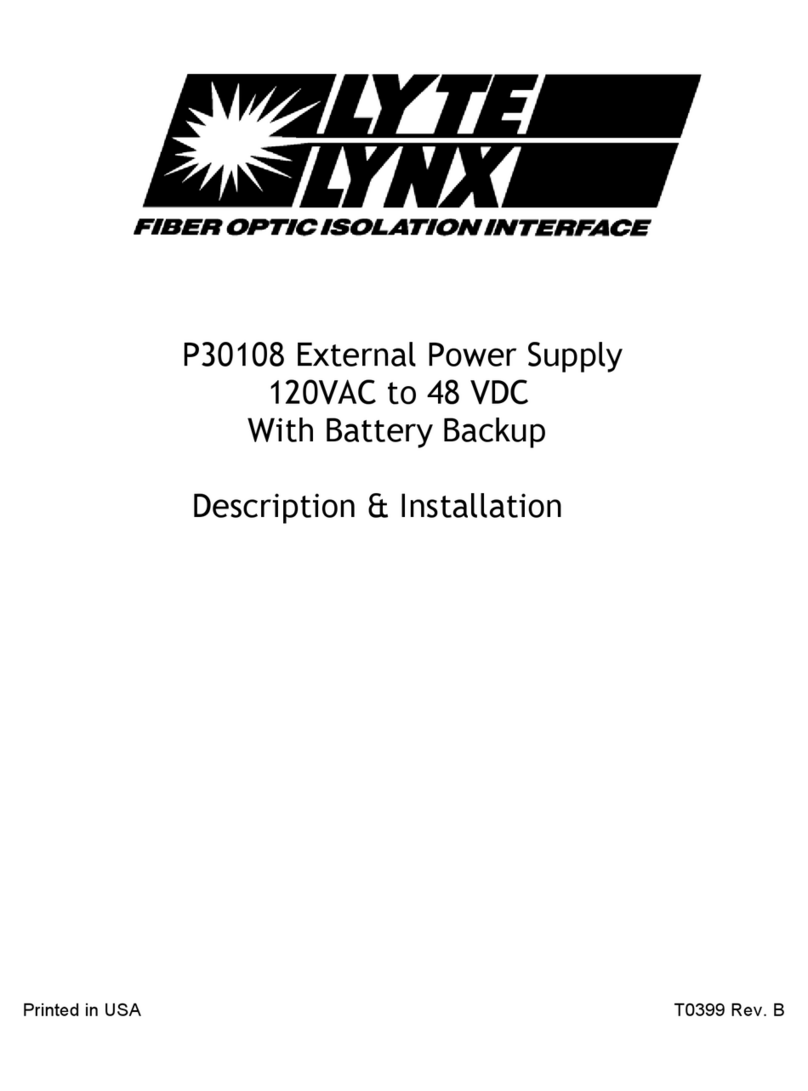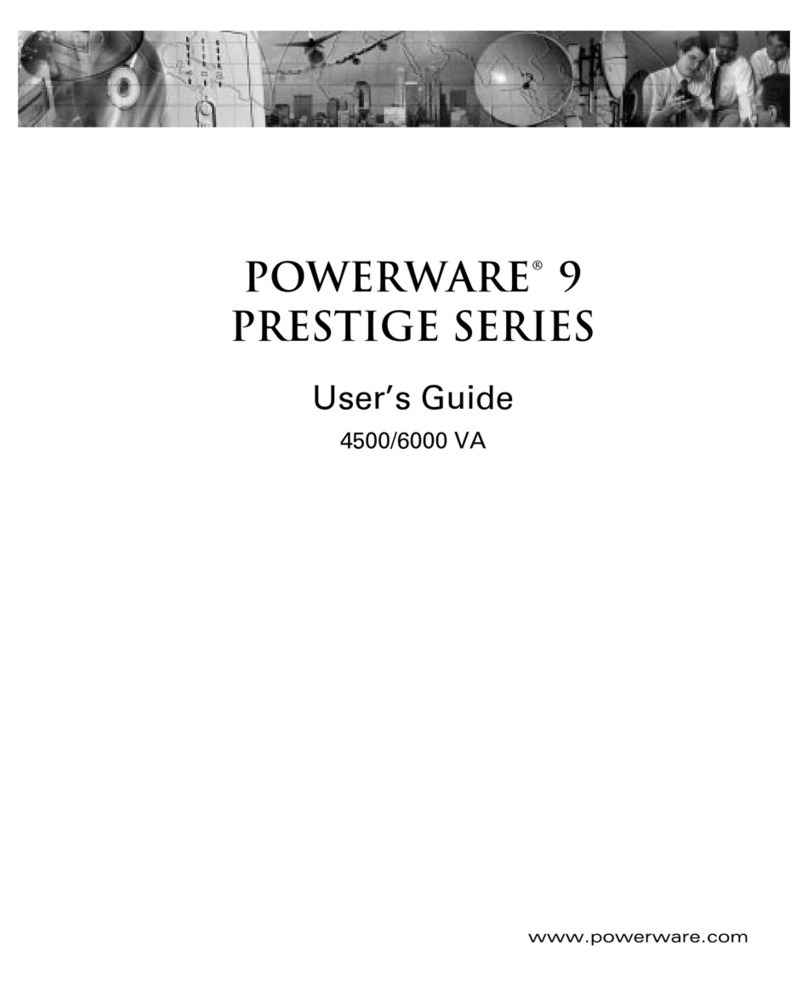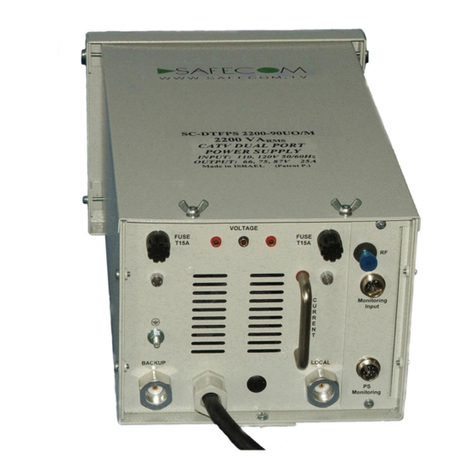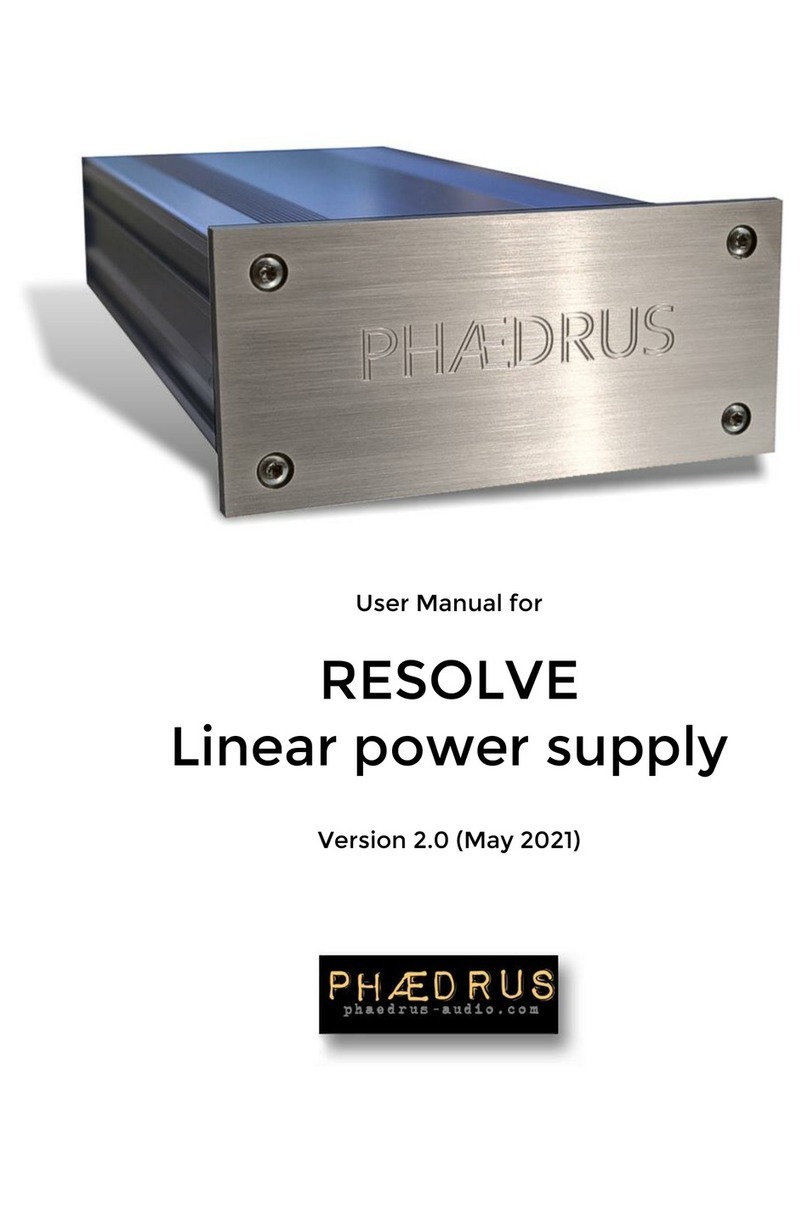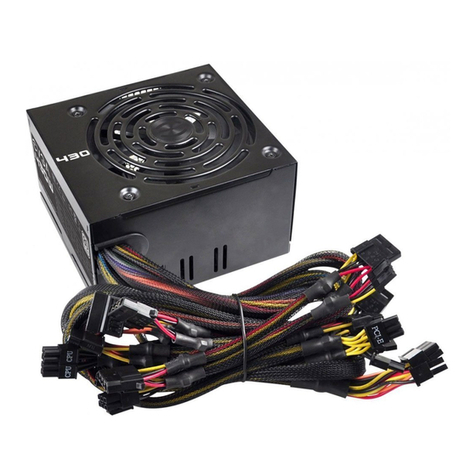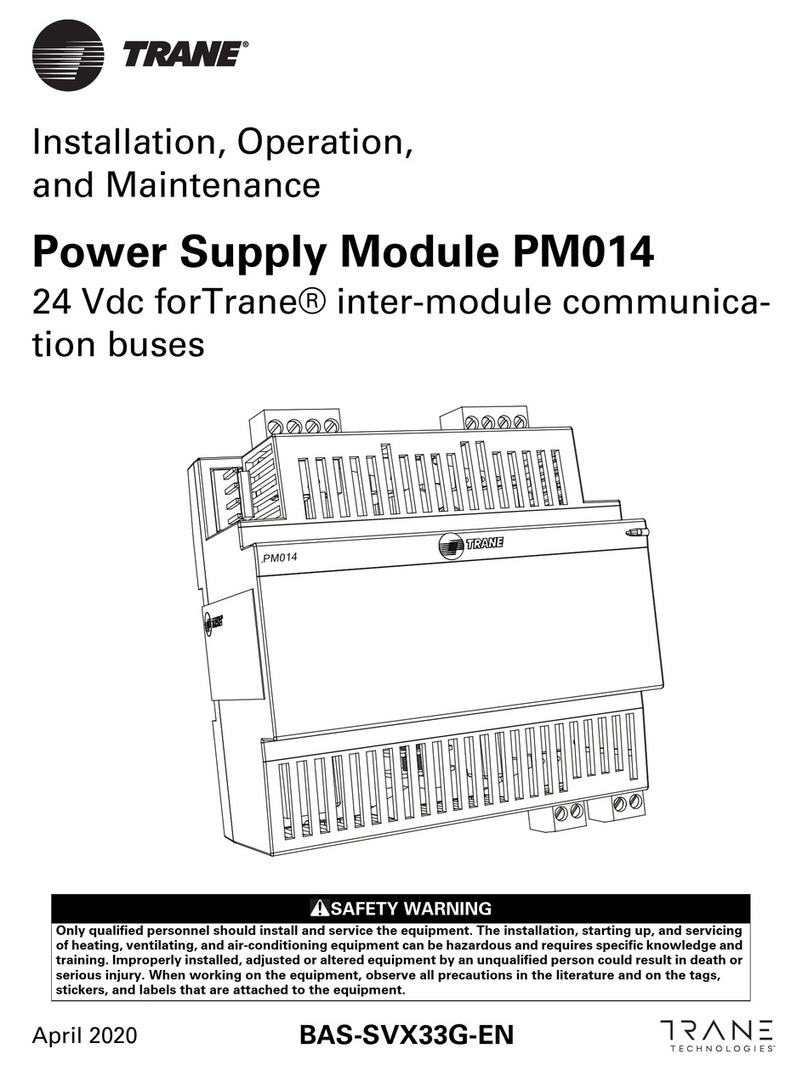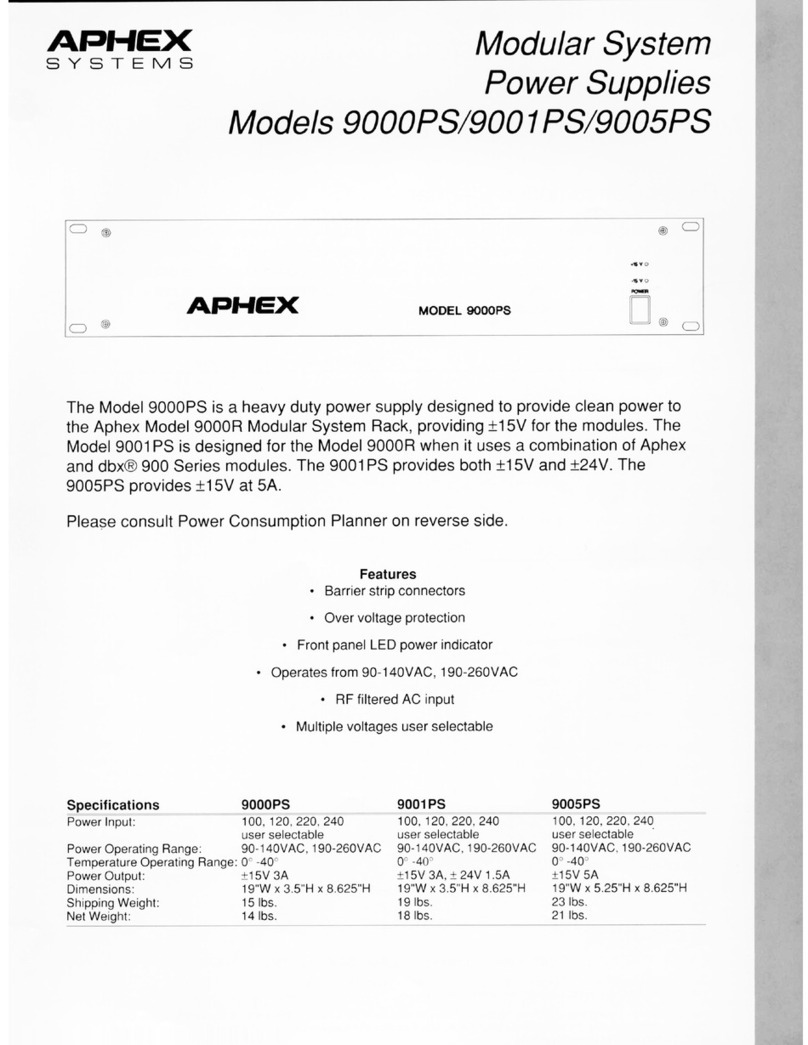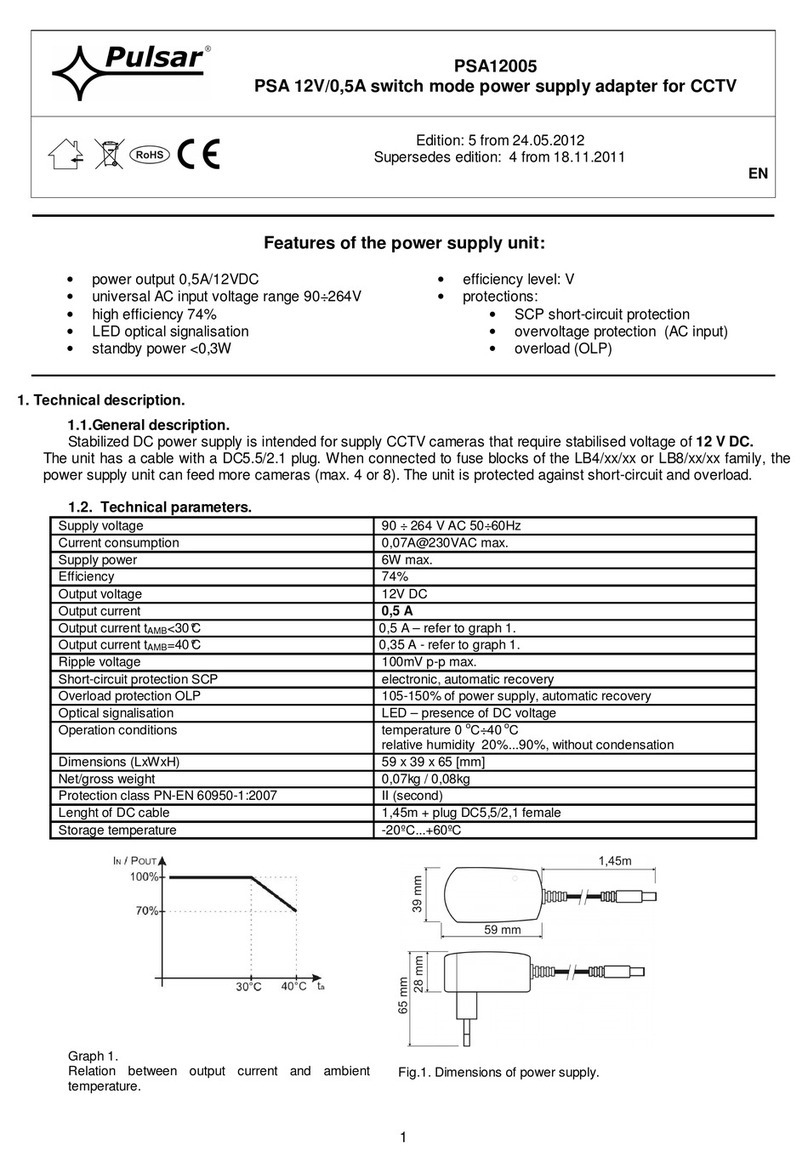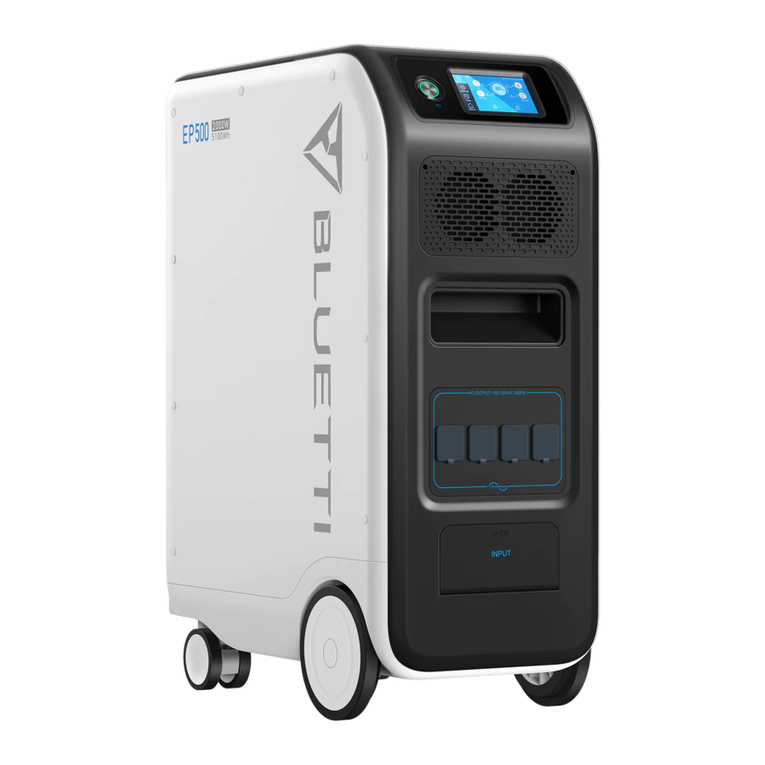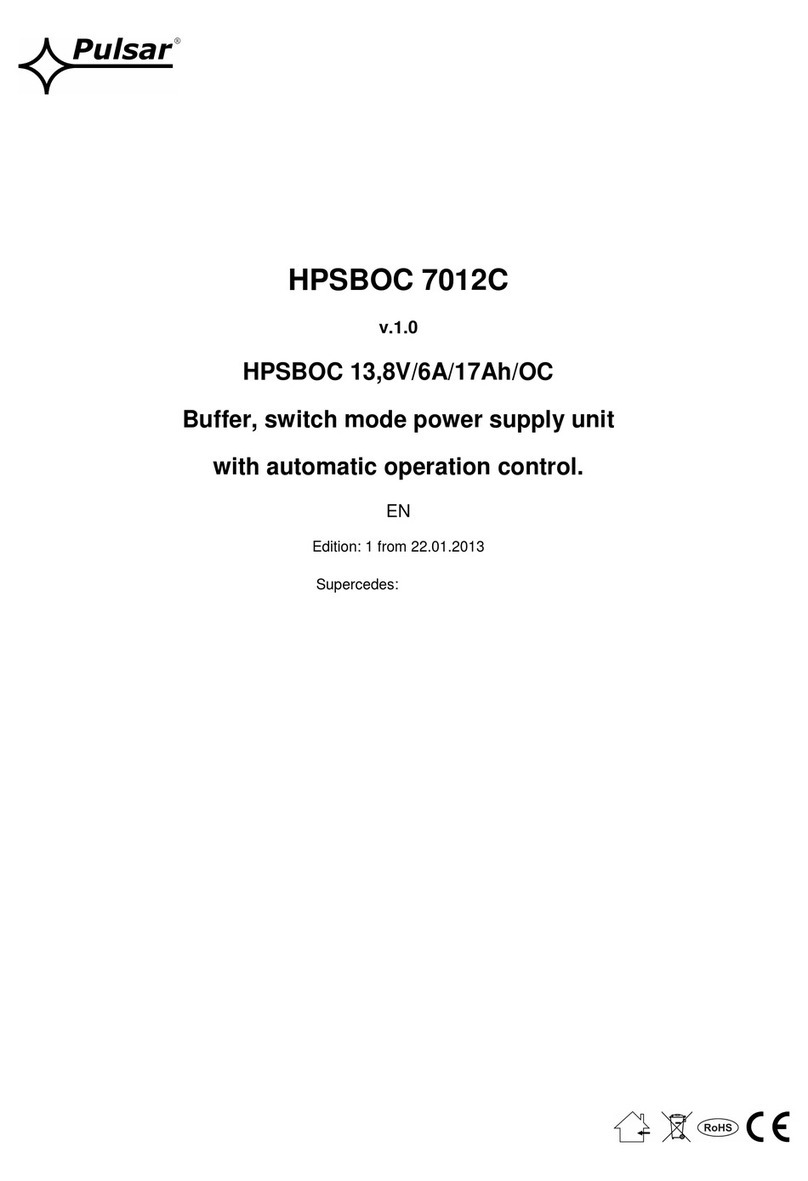TTI EX752M User manual

EX752M
75V/150V Multi-mode Dual DC Power Supply
INSTRUCTION MANUAL

1
Table of Contents
Introduction 2
Specification 2
Safety 4
Installation 5
Connections 5
Operation 6
Maintenance 8
Instructions en Francais 9
Bedienungsanleitung auf Deutsch 14
Istruzioni in Italiano 19
Instrucciones en Español 24

2
Introduction
The EX752M is a dual output 300 watt PSU with Multi-Mode capability in a compact and
attractive case.
The Multi-Mode capability enables it to operate as a dual power supply with two independent and
isolated outputs, or as a single power supply of double the power. As a dual, each output
provides 0 to 75V at 0 to 2A (Mode A). As a single the output can be selected as either 0 to 75V
at 0 to 4A (Mode B) or 0 to 150V at 0 to 2A (Mode C). In single modes, the unused half of the
unit becomes completely inoperative and its displays are blanked.
The EX series incorporates separate digital voltage and current meters on each output. The
meters use bright 14mm (0.56”) LED displays and have an update rate of 4 per second providing
near instantaneous response. Simultaneous metering of voltage and current provides accurate
information “at a glance” and avoids any possibility of misinterpretation. When an output switch is
set to “off”, the current limit setting is displayed enabling conditions to be set before the load is
connected.
Excellent line and load regulation are matched by low noise and good transient response. High
power efficiency ensures that the unit remains cool without any fan noise.
The EX752M has been designed to meet the stringent requirements of relevant IEC standards
for safety and EMC, including harmonics emissions. All outputs are intrinsically short circuit proof,
and are protected against external voltages and reverse currents.
Specification
OUTPUTS
Voltage Range: 0V to 75V minimum, Modes A and B.
0V to 150V minimum, Mode C.
Current Range: 0A to 2A minimum, Modes A and C.
0A to 4A minimum, Mode B.
Output Voltage Setting:
By coarse and fine controls.
Output Current Setting:
By single logarithmic control.
Operating Mode:
Constant voltage or constant current with automatic cross-over.
Output Switch:
Electronic. Preset voltage and current displayed when off.
Output Terminals:
Universal 4mm safety binding posts on 19mm (0·75”) spacing
Output Protection: Output will withstand forward voltage of up to 85V (Modes A and B) or
170V (Mode C).
Reverse protection by diode clamp for reverse currents up to 3A.
Load Regulation: <0.01% of maximum output for a 90% load change (Modes A & B).
<0.1% of maximum output for a 90% load change (Mode C).
Line Regulation:
<0.01% of maximum output for a 10% line change.
Ripple & Noise
(20MHz bandwidth):
Typically <2mVrms, <15mV pk-pk, constant voltage mode.
Transient Response: <200µs to within 50mV of set level for a 5% to 95% load change
(Mode A).
Temperature Coefficient:
Typically <100ppm/°C
Status Indication:
Output on lamp. Constant current mode lamp.

3
OPERATING MODES
Mode Selection:
By front panel rotary switch.
Mode A:
Independent outputs each capable of 0-75V at 0-2A.
Mode B: Output 2 only active, 0-75V at 0-4A.
Output 1 disabled.
Mode C: Output 2 only active, 0-150V at 0-2A.
Output 1 disabled.
METER SPECIFICATIONS
Meter Types:
Dual 3 digit meters with 14mm (0.56") LEDs. Reading rate 4 Hz.
Meter Resolutions:
100mV, 10mA
Meter Accuracies: Voltage 0.3% of reading ± 1 digit,
Current 0.6% of reading ± 1 digit
Operating Modes:
Output 1 meters are blanked in Modes B and C.
GENERAL
AC Input:
110V-240V AC ±10%. Installation Category II.
Power Consumption:
500VA max.
Operating Range:
+5ºC to +40ºC, 20% to 80% RH.
Storage Range:
−40ºC to + 70ºC.
Environmental:
Indoor use at altitudes up to 2000m, Pollution Degree 2.
Safety & EMC: Complies with EN61010-1 & EN61326-1.
For details, request the EU Declaration of Conformity for this
instrument via http://www.aimtti.com/support (serial no. needed).
Size:
260 x 160 x 320mm (WxHxD).
Weight:
4.3kg

4
Safety
This power supply is a Safety Class I instrument according to IEC classification and has been
designed to meet the requirements of EN61010-1 (Safety Requirements for Electrical Equipment
for Measurement, Control and Laboratory Use). It is an Installation Category II instrument
intended for operation from a normal single phase supply.
This instrument has been tested in accordance with EN61010-1 and has been supplied in a safe
condition. This instruction manual contains some information and warnings which have to be
followed by the user to ensure safe operation and to retain the instrument in a safe condition.
This instrument has been designed for indoor use in a Pollution Degree 2 environment in the
temperature range 5°C to 40°C, 20% - 80% RH (non-condensing). It may occasionally be
subjected to temperatures between +5°C and –10°C without degradation of its safety. Do not
operate while condensation is present.
Use of this instrument in a manner not specified by these instructions may impair the safety
protection provided. Do not operate the instrument outside its rated supply voltages or
environmental range.
WARNING! THIS INSTRUMENT MUST BE EARTHED
Any interruption of the mains earth conductor inside or outside the instrument will make the
instrument dangerous. Intentional interruption is prohibited. The protective action must not be
negated by the use of an extension cord without a protective conductor.
When the instrument is connected to its supply, terminals may be live and opening the covers or
removal of parts (except those to which access can be gained by hand) is likely to expose live
parts. The apparatus shall be disconnected from all voltage sources before it is opened for any
adjustment, replacement, maintenance or repair. Capacitors inside the power supply may still be
charged even if the power supply has been disconnected from all voltage sources but will be
safely discharged about 10 minutes after switching off power.
Any adjustment, maintenance and repair of the opened instrument under voltage shall be
avoided as far as possible and, if inevitable, shall be carried out only by a skilled person who is
aware of the hazard involved.
If the instrument is clearly defective, has been subject to mechanical damage, excessive
moisture or chemical corrosion the safety protection may be impaired and the apparatus should
be withdrawn from use and returned for checking and repair.
Make sure that only fuses with the required rated current and of the specified type are used for
replacement. The use of makeshift fuses and the short-circuiting of fuse holders is prohibited.
Do not wet the instrument when cleaning it.
The following symbols are used on the instrument and in this manual:-
Earth (ground) terminal.
mains supply OFF.
l
mains supply ON.
alternating current (ac)
direct current (dc)
Caution – risk of danger. Refer to the documentation (this
manual) to find out the nature of the potential hazard and any
actions which have to be taken.

5
Installation
Mains Operating Voltage
This instrument has a universal input range and will operate from a nominal 115V or 230V mains
supply without adjustment. Check that the local supply meets the AC Input requirement given in
the Specification.
Mains Lead
Connect the instrument to the AC supply using the mains lead provided. Should a mains plug be
required for a different mains outlet socket, a suitably rated and approved mains lead set should be
used which is fitted with the required wall plug and an IEC60320 C13 connector for the instrument
end. To determine the minimum current rating of the lead-set for the intended AC supply, refer to the
power rating information on the equipment or in the Specification.
WARNING! THIS INSTRUMENT MUST BE EARTHED.
Any interruption of the mains earth conductor inside or outside the instrument will make the
instrument dangerous. Intentional interruption is prohibited.
Ventilation
The power supply is very efficient but nevertheless can generate significant heat at full power.
The supply relies on convection cooling only and it is therefore important that ventilation is never
restricted if performance and safety are to be maintained.
Connections
All connections are made from the front panel.
The load should be connected to the positive (red) and negative (black) terminals marked
OUTPUT. Connect to one or both outputs as appropriate for the selected Mode, see Operation
section.
Warning! Voltages above 70Vdc are hazardous live according to EN 61010-1 and great care must
be taken when using the power supply at voltages above this level.
The universal safety binding posts used for the output meet the requirements for reinforced
insulation for voltages up to 250Vdc because creepage and clearance to the terminal contacts is
>2.5mm even with the binding post fully open. However, it is highly recommended that the binding
posts are usually fully tightened and that connections are only made using leads fitted with
fixed-shroud 4mm safety plugs. Make sure that the circuit to which connections are made
is appropriately insulated; no accessible parts of the external circuit should become
hazardous live in normal or single fault condition as defined by EN61010-1.
Always make connections to the instrument with the OUTPUT off.
The terminal marked is connected to the chassis and safety earth ground.

6
Operation
The operation of both outputs is identical in ModeA (independent mode); the following
description applies to both. In Mode B and Mode C only Output 2 is active and Output 1 is
disabled; the description therefore only applies to Output 2, see Mode Selection section.
Setting Up the Output
With the POWER switch on (l) and the output off the output voltage and current limit can be
accurately preset using the VOLTAGE and CURRENT controls; the left-hand meter shows the set
voltage and the right-hand meter shows the set maximum current.
When the output switch is switched on, the ON lamp lights; the left-hand meter now shows
the actual voltage and the right-hand meter the actual load current.
Constant Voltage
The output voltage is adjusted using the coarse and fine VOLTAGE controls; the CURRENT
control sets the maximum current that can be supplied.
Constant Current
If the load resistance is low enough such that, at the output voltage set, a current greater than
the current limit setting would flow, the power supply will automatically move into constant current
operation. The current output is adjusted by the CURRENT control and the VOLTAGE controls
set the maximum voltage that can be generated.
The CC lamp lights to show constant current mode.
Instantaneous Current Output
The current limit control can be set to limit the continuous output current to levels down to 10mA.
However, in common with all precision bench power supplies, a capacitor is connected across
the output to maintain stability and good transient response. This capacitor charges to the output
voltage and short-circuiting of the output will produce a current pulse as the capacitor discharges
which is independent of the current limit setting.
Mode Selection
The three operating modes are selected by the front panel rotary switch situated between the
terminals.
Caution. Turn both outputs off before changing mode. Possible damage to the circuit being
powered, and to the unit itself, may occur if the mode is switched with either output still on.
Mode A: With the switch in this position the outputs operate independently and are isolated from
one another. The voltage range on each output is 0-75V and the current range 0-2A.
Mode B: With the switch in this position only Output 2 is active; the voltage range is 0-75V and
the current range is 0-4A. The controls of Output 1 are inoperative and the display is blanked.
The terminals of Output 1 are isolated from those of Output 2.
Note that with the output switch of Output 1 in the ‘ON’ position the Output lamp still lights but the
terminals remain open-circuit.
Note also that the range and scaling of the current limit control doubles when changing from Mode
A to Mode B, i.e. with the control set for a 1.5A limit in Mode A, the limit becomes 3A in Mode B.
To avoid possible damage to the circuit being tested the outputs should be switched off before the
mode is changed and the current limit set to the desired value before the output is switched on.

7
Mode C: With the switch in this position only Output 2 is active; the voltage range is 0-150V
and the current range is 0-2A. The controls of Output 1 are inoperative and the display is
blanked. The red terminal of Output 1 is isolated but the black terminal remains connected
internally to the black terminal of Output 2.
Note that when the output switch of Output 1 is in the ‘ON’ position the Output lamp still lights
but the red terminal remains open-circuit.
Note also that the range and scaling of the voltage controls of Output 2 double when changing
from Mode B to Mode C, i.e. with the controls set for 60V in Mode B the output voltage
becomes 120V in Mode C. Care should therefore be taken to ensure that the outputs are
switched off before the mode is changed and that the output is set to the correct voltage
before it is switched on.
Protection
The output has intrinsic short-circuit protection and is protected from reverse voltages by a diode;
the continuous reverse current must not exceed 3 Amps, although transients can be much higher.
The output is protected against externally applied forward voltages of up to 85V (Modes A and B)
or 170V (Mode C).
Connection to the Load
The load should be connected to the positive (red) and negative (black) OUTPUT terminals. Both
are fully floating and either can be connected to ground.
Warning! Voltages above 70Vdc are hazardous live according to EN 61010-1 and great care must
be taken when using the power supply at voltages above this level.
It is highly recommended that connections are only made using leads fitted with fixed-
shroud 4mm safety plugs. Make sure that the circuit to which connections are made is
appropriately insulated; no accessible parts of the external circuit should become
hazardous live in normal or single fault condition as defined by EN61010-1.
Always make connections to the instrument with the OUTPUT off.
Series or Parallel Connection with Other Outputs
The outputs of the power supply are fully floating and may be used in series with other power
supply units to generate high DC voltages up to 300V DC.
Warning! Voltages above 70Vdc are hazardous live according to EN 61010-1 and great care must
be taken when using the power supply at voltages above this level
The maximum permissible voltage between any terminal and earth ground ( ) is 300VDC; the
maximum permissible voltage between either terminal of one output and any terminal of another
output on the same supply is also 300VDC.
All connections to the terminals must be made with the output switched off on all units.
It should be noted that the unit can only source current and cannot sink it, thus units cannot be
series connected in anti-phase.
The unit can be connected in parallel with others to produce higher currents. Where several units
are connected in parallel, the output voltage will be equal to that of the unit with the highest
output voltage setting until the current drawn exceeds its current limit setting, upon which the
output will fall to that of the next highest setting, and so on. In constant current mode, units can
be connected in parallel to provide a current equal to the sum of the current limit settings.

8
Maintenance
The Manufacturers or their agents overseas will provide repair for any unit developing a fault.
Where owner wish to undertake their own maintenance work, this should only be done by skilled
personnel in conjunction with the service manual which may be purchased directly from the
Manufacturers or their agents overseas.
Fuse
The correct fuse type is:
10 Amp 250V HBC time-lag(T), 5 x 20mm.
Note that the main function of the fuse is to make the instrument safe and limit damage in the
event of failure of one of the switching devices. If a fuse fails it is therefore very likely that the
replacement will also blow, because the supply has developed a fault; in such circumstances the
instrument will need to be returned to the manufacturer for service.
Make sure that only fuses of the required rated current and specified type are used for
replacement. The use of makeshift fuses and the short-circuiting of fuse-holders is prohibited.
To replace a fuse, first disconnect the instrument from the AC supply. Remove the 6 cover
securing screws and lift off the cover. Replace the fuse with one of the correct type and refit the
cover.
Cleaning
If the PSU requires cleaning use a cloth that is only lightly dampened with water or a mild
detergent. Polish the display window with a soft dry cloth.
WARNING! TO AVOID ELECTRIC SHOCK, OR DAMAGE TO THE PSU, NEVER ALLOW
WATER TO GET INSIDE THE CASE. TO AVOID DAMAGE TO THE CASE OR DISPLAY
WINDOW NEVER CLEAN WITH SOLVENTS.

9
Sécurité
Cet instrument est de Classe de sécurité 1 suivant la classification IEC et il a été construit pour
satisfaire aux impératifs EN61010-1 (Impératifs de sécurité pour le matériel électrique en vue de
mesure, commande et utilisation en laboratoire). Il s'agit d'un instrument d'installation Catégorie
II devant être exploité depuis une alimentation monophasée habituelle.
Cet instrument a été soumis à des essais conformément à EN61010-1 et il a été fourni en tout
état de sécurité. Ce manuel d'instructions contient des informations et avertissements qui doivent
être suivis par l'utilisateur afin d'assurer un fonctionnement de toute sécurité et de conserver
l'instrument dans un état de bonne sécurité.
Cet instrument a été conçu pour être utilisé en interne dans un environnement de pollution
Degré 2, plage de températures 5°C à 40°C, 20% - 80% HR (sans condensation). Il peut être
soumis de temps à autre à des températures comprises entre +5°C et –10°C sans dégradation
de sa sécurité. Ne pas l'utiliser lorsqu'il y a de la condensation.
Toute utilisation de cet instrument de manière non spécifiée par ces instructions risque d'affecter
la protection de sécurité conférée. Ne pas utiliser l'instrument à l'extérieur des tensions
d'alimentation nominales ou de la gamme des conditions ambiantes spécifiées.
AVERTISSEMENT! CET INSTRUMENT DOIT ETRE RELIE ALA TERRE
Toute interruption du conducteur de terre secteur à l'intérieur ou à l'extérieur de l'instrument
rendra l'instrument dangereux. Il est absolument interdit d'effectuer une interruption à dessein.
Ne pas utiliser de cordon de prolongation sans conducteur de protection, car ceci annulerait sa
capacité de protection.
Lorsque l'instrument est relié à son alimentation, il est possible que les bornes soient sous
tension et par suite, l'ouverture des couvercles ou la dépose de pièces (à l'exception de celles
auxquelles on peut accéder manuellement) risque de mettre à découvert des pièces sous
tension. Il faut débrancher toute source de tension éventuelle de l'appareil avant de l'ouvrir pour
effectuer des réglages, remplacements, travaux d'entretien ou de réparations. Les
condensateurs qui se trouvent dans le bloc d'alimentation risquent de rester chargés, même si le
bloc d'alimentation a été déconnecté de toutes les sources de tension, mais ils se déchargeront
en toute sécurité environ 10 minutes après extinction de l'alimentation.
Eviter dans la mesure du possible d'effectuer des réglages, travaux de réparations ou d'entretien
lorsque l'instrument ouvert est branché à une source d'alimentation, mais si c'est absolument
nécessaire, seul un technicien compétent au courant des risques encourus doit effectuer ce
genre de travaux.
S'il est évident que l'instrument est défectueux, qu'il a été soumis à des dégâts mécaniques, à
une humidité excessive ou à une corrosion chimique, la protection de sécurité sera amoindrie et
il faut retirer l'appareil, afin qu'il ne soit pas utilisé, et le renvoyer en vue de vérifications et de
réparations.
Uniquement remplacer les fusibles par des fusibles d'intensité nominale requise et de type
spécifié. Il est interdit d'utiliser des fusibles bricolés et de court-circuiter des porte-fusibles.
Eviter de mouiller l'instrument lors de son nettoyage.
Les symboles suivants se trouvent sur l'instrument, ainsi que dans ce manuel.
Borne de terre (masse) courant continu (c.c.)
alimentation secteur OFF (éteinte)
courant alternatif (c.a.)
l alimentation secteur ON (allumée) Attention : risque de danger. Veuillez
consulter la documentation (ce manuel) pour
trouver la nature du danger potentiel et toute
action qui doit être prise.

10
Installation
Tension de secteur opérationnelle
Cet instrument a une plage d'entrée universelle et il fonctionne sur une alimentation secteur de
115 V ou de 230 V, tension nominale, sans ajustement aucun. Vérifier que l'alimentation locale
satisfait aux impératifs d'entrée c.a. indiqués aux Caractéristiques techniques.
Câble secteur
Brancher l’appareil sur l’alimentation secteur à l’aide du cordon secteur fourni. S’il s’avère
nécessaire d’utiliser une fiche secteur destinée à un autre type de prise murale, employer un
cordon secteur correctement dimensionné et homologué en l’équipant de la fiche murale voulue
et d’un connecteur IEC60320 C13 du côté de l’appareil. Pour déterminer l’intensité nominale
minimale du cordon en fonction de l’alimentation sur secteur prévue, consulter les
caractéristiques de puissance nominale figurant sur le matériel ou dans le chapitre
Spécifications.
AVERTISSEMENT ! CET APPAREIL DOIT ETRE RELIÉ À LA TERRE.
Toute interruption du conducteur de terre de la prise secteur à l'intérieur ou à l'extérieur de
l’appareil rendra ce dernier dangereux. Il est interdit d'effectuer une coupure intentionnelle.
Ventilation
L’alimentation est très performante, mais elle peut toutefois générer beaucoup de chaleur à
puissance maximale. L’alimentation a besoin d’un refroidissement par convection uniquement et
il est donc important que la ventilation ne soit jamais réduite, afin d’assurer une bonne
performance et sécurité.
Connexions
Toutes les connexions sont effectuées au panneau avant.
La charge doit être reliée aux bornes positive (rouge) et négative (noire) marquées OUTPUT
(Sortie). Relier à une sortie ou aux deux, selon les besoins, pour le mode sélectionné, voir la
section Fonctionnement.
Avertissement ! Les tensions supérieures à 70 Vcc sont dangereuses sous tension selon la norme
EN 61010-1 et le plus grand soin doit être pris lors de l'utilisation de tensions supérieures à ce
niveau.
Les bornes d'attache de sécurité universelles utilisées pour la sortie satisfont aux conditions
d'isolation renforcée pour des tensions supérieures à 250 Vcc, car les lignes de fuite et la distance
d'isolement jusqu'aux contacts de la borne sont >2,5 mm, même lorsque la borne est totalement
ouverte. Toutefois, il est vivement recommandé de serrer les bornes d'attache à fond et de
n’effectuer les connexions qu'à l'aide de fils munis de bouchons de sécurité à protection
fixe de 4 mm. S’assurer que le circuit sur lequel sont effectuées les connexions est
correctement isolé ; aucune des pièces accessibles du circuit externe ne devrait être
dangereuse lorsque l'appareil est sous tension dans des conditions normales ou lorsqu'une
seule faute est détectée, conformément à la norme EN61010-1.
OUTPUT (sortie) doit toujours être hors tension lors de la connexion à l’instrument.
La borne désignée est reliée au châssis et à la terre de protection.

11
Fonctionnement
Le fonctionnement des deux sorties est identique en mode A (mode indépendant); la description
suivante s'applique aux deux. En mode B et en mode C seule la sortie 2 est active et la sortie 1
est désactivée; la description s'applique donc uniquement à la sortie 2, voir la section Sélection
de mode.
Réglage de la sortie
L’interrupteur POWER (alimentation) sur (l) et la sortie éteinte, il est possible de régler avec
précision la limite de tension et de courant de sortie au moyen des commandes VOLTAGE
(Tension) et CURRENT (Courant); l’appareil de mesure gauche indique la tension réglée et
l’appareil droit le courant maximum réglé.
Lorsque le commutateur de sortie est sur marche, le témoin ON (Marche) s’allume;
l’appareil de mesure gauche indique alors la tension véritable et l’appareil droit le courant de
charge véritable.
Tension constante
Les commandes VOLTAGE de réglage grossier et de précision permettent d’ajuster la tension de
sortie; la commande CURRENT règle le courant maximum qui peut être fourni.
Courant constant
Si la résistance de charge est suffisamment basse qu’un courant supérieur au réglage de limite
de courant puisse passer pour la tension de sortie réglée, l’alimentation passera
automatiquement en mode de fonctionnement de courant constant. La commande CURRENT
ajuste le courant de sortie et les commandes VOLTAGE règlent la tension maximale qui peut être
engendrée. Le témoin CC s’allume pour indiquer le mode de courant constant.
Sortie de courant instantanée
Il est possible de régler la commande de limite de courant pour limiter le courant de sortie
continu à des niveaux aussi bas que 10 mA. Toutefois, ainsi que c’est le cas de toutes les
alimentations de précision sur banc, un condensateur est relié aux bornes de la sortie, afin de
maintenir la stabilité, ainsi qu’une bonne réponse transitoire. Ce condensateur se charge jusqu’à
la tension de sortie, et le court-circuitage de la sortie produira une impulsion de courant, lors du
déchargement du condensateur indépendamment du réglage de limite de courant.
Sélection de mode
Les trois modes de fonctionnement sont sélectionnés par le commutateur rotatif du panneau
avant situé entre les bornes.
Attention. Désactiver les deux sorties avant de changer de mode. On risque en effet d'endommager
le circuit alimenté, ainsi que l'appareil en question si le mode est opérationnel lorsqu'une des deux
sorties est toujours activée.
Mode A: Le commutateur dans cette position, les sorties fonctionnent indépendamment et elles
sont isolées l'une de l'autre. La plage de tension à chaque sortie est de 0-75 V et la plage
d'intensité 0-2 A.
Mode B: Le commutateur dans cette position, seule la sortie 2 est active; la plage de tension est
de 0-75 V et la plage d'intensité 0-4 A. Les commandes de la sortie 1 sont inopérationnelles et
l'affichage est occulté. Les bornes de la sortie 1 sont isolées de celles de la sortie 2.
Noter que lorsque la sortie 1 du commutateur de sortie est sur "ON" (Marche), le témoin de sortie
est toujours allumé, mais la borne reste en circuit ouvert.
Noter également que la gamme et la mise à l'échelle de la commande de limite de courant doublent
de valeur lorsqu'on passe du mode A au mode B, c.-à-d. que lorsque la commande est réglée à
une limite de 1,5 A en mode A, la limite passe à 3 A en mode B. Pour éviter d'endommager le circuit
soumis aux essais, il est recommandé de désactiver les sorties avant de changer de mode et de
régler la limite de courant à la valeur désirée avant d'activer la sortie.

12
Mode C: Le commutateur dans cette position, seule la sortie 2 est active; la plage de tension est de
0-150 V et la plage d'intensité 0-2 A. Les commandes de la sortie 1 sont inopérationnelles et
l'affichage est occulté. La borne rouge de la sortie 1 est isolée, mais la borne noire reste
connectée en interne à la borne noire de la sortie 2.
Noter que lorsque la sortie 1 du commutateur de sortie est sur "ON" (Marche), le témoin de sortie
est toujours allumé, mais la borne rouge reste en circuit ouvert.
Noter également que la gamme et la mise à l'échelle des commandes de tension de la sortie 2
doublent de valeur lorsqu'on passe du mode B au mode C, c.-à-d. que lorsque les commandes
sont réglées à 60 V en mode B, la tension de sortie passe à 120 V en mode C. Il faut donc veiller à
désactiver les sorties avant de changer de mode et à régler la sortie à la tension correcte avant de
l'activer.
Protection
La sortie dispose d’une protection intrinsèque contre les courts-circuits et elle est protégée contre
la tension inverse par une diode; le courant inverse continu ne doit pas dépasser 3 A, bien qu’il
soit possible que l’intensité des transitoires soit nettement supérieure.
La sortie est protégée contre des tensions directes appliquées en externe jusqu'à 85 V (Modes A
et B) ou jusqu'à 170 V (Mode C).
Connexion à la charge
La charge devra être connectée aux bornes OUTPUT positive (rouge) et négative (noire). Les
deux sont entièrement flottantes et l’une ou l’autre peuvent être connectées à la masse.
Avertissement ! Les tensions supérieures à 70 Vcc sont dangereuses sous tension selon la norme
EN 61010-1 et le plus grand soin doit être pris lors de l'utilisation de tensions supérieures à ce niveau.
Il est vivement recommandé de n’effectuer de connexions qu'à l'aide de fils munis de
bouchons de sécurité à protection fixe de 4 mm. S’assurer que le circuit sur lequel sont
effectuées les connexions est correctement isolé ; aucune des pièces accessibles du circuit
externe ne devrait être dangereuse lorsque l'appareil est sous tension dans des conditions
normales ou lorsqu'une seule faute est détectée, conformément à la norme EN61010-1.
OUTPUT (sortie) doit toujours être hors tension lors de la connexion à l'instrument.
Connexion en série ou en parallèle avec d’autres sorties
Les sorties de l’alimentation sont entièrement flottantes et elles peuvent être utilisées en série
avec d’autres blocs d’alimentation, afin de produire des tensions c.c. jusqu’à 300 V c.c.
Avertissement ! Les tensions supérieures à 70 Vcc sont dangereuses sous tension selon la norme
EN 61010-1 et le plus grand soin doit être pris lors de l'utilisation de tensions supérieures à ce niveau.
La tension maximale admissible entre une borne et la terre ( ) est de 300 V c.c.; la tension
maximale admissible entre la borne d'une sortie et la borne d'une autre sortie de la même
alimentation est également de 300 V c.c.
AVERTISSEMENT! Effectuer toutes les connexions aux bornes, la sortie désactivée à tous
les appareils.
Il faut noter que le bloc peut uniquement recevoir du courant, mais non le consommer, de sorte
qu’il n’est pas possible de mettre en opposition de phase les blocs reliés en série.
Il est possible de relier le bloc en parallèle avec d’autres, afin de produire des courants de haute
intensité. Lorsque plusieurs blocs sont reliés en parallèle, la tension de sortie doit être égale à
celle du bloc de réglage de tension de sortie le plus élevé, jusqu’à ce que le courant consommé
dépasse le réglage de limite de courant, auquel cas la sortie descend à celle du réglage le plus
haut suivant, etc. En mode de courant constant, les blocs peuvent être reliés en parallèle, afin
de donner un courant égal à la somme des réglages de limite de courant.

13
Maintenance
Le Constructeur ou ses agents à l'étranger répareront tout bloc qui tombe en panne. Si le
propriétaire de l'appareil décide d'effectuer lui-même la maintenance, ceci doit uniquement être
effectué par un personnel spécialisé qui doit se référer au manuel d’entretien que l'on peut se
procurer directement auprès du Constructeur ou de ses agents à l'étranger.
Fusible
Type de fusible correct:
10 A250 V HBC temporisé (T), 5 x 20 mm.
Il faut noter que l’objet principal de ce fusible est de rendre l’instrument non dangereux et de
limiter les dégâts en cas de panne d’un des dispositifs de commutation. En cas de panne d’un
fusible, il est très probable que le fusible de rechange sautera également, étant donné que
l’alimentation est probablement défectueuse; lorsque c’est le cas, il faudra renvoyer l’instrument
chez le constructeur en vue de réparations.
Uniquement remplacer les fusibles par des fusibles d'intensité nominale requise et de type
spécifié. Il est interdit d'utiliser des fusibles bricolés et de court-circuiter des porte-fusibles.
Pour remplacer un fusible, commencer par débrancher l’instrument de l’alimentation c.a. Enlever
les 6 vis d’immobilisation du couvercle, puis enlever le couvercle. Remplacer le fusible par un
autre de type correct, puis remettre le couvercle.
Nettoyage
S'il faut nettoyer le bloc d'alimentation, utiliser un chiffon légèrement imbibé d'eau ou d'un
détergent doux. Nettoyer le cadran d'affichage au moyen d'un chiffon sec et doux.
AVERTISSEMENT! EMPECHER TOUTE INTRODUCTION D'EAU DANS LE BOITIER AFIN
D'EVITER TOUT CHOC ELECTRIQUE ET DEGATS AU BLOC D'ALIMENTATION. NE JAMAIS
UTILISER DE DISSOLVANTS POUR NETTOYER LE BLOC, AFIN D'EVITER
D'ENDOMMAGER LE BOITIER OU LE CADRAN D’AFFICHAGE.

14
Sicherheit
Dieses Gerät wurde nach der Sicherheitsklasse (Schutzart) I der IEC-Klassifikation und gemäß
den europäischen Vorschriften EN61010-1 (Sicherheitsvorschriften für elektrische Meß-, Steuer,
Regel- und Laboranlagen) entwickelt. Es handelt sich um ein Gerät der Installationskategorie II,
das für den Betrieb von einer normalen einphasigen Versorgung vorgesehen ist.
Das Gerät wurde gemäß den Vorschriften EN61010-1 geprüft und wurde in sicherem Zustand
geliefert. Die vorliegende Anleitung enthält vom Benutzer zu beachtende Informationen und
Warnungen, die den sicheren Betrieb und den sicheren Zustand des Gerätes gewährleisten.
Dieses Gerät ist für den Betrieb in Innenräumen der Umgebungsklass 2 , für einen
Temperaturbereich von 5° C bis 40° C und 20 - 80 % relative Feuchtigkeit (nicht kondensierend)
vorgesehen. Gelegentlich kann es Temperaturen zwischen +5° und –10°C ausgesetzt sein, ohne
daß seine Sicherheit dadurch beeinträchtigt wird. Betreiben Sie das Gerät jedoch auf keinen Fall,
solange Kondensation vorhanden ist.
Ein Einsatz dieses Geräts in einer Weise, die für diese Anlage nicht vorgesehen ist, kann die
vorgesehene Sicherheit beeinträchtigen. Auf keinen Fall das Gerät außerhalb der angegebenen
Nennversorgungsspannungen oder Umgebungsbedingungen betreiben.
WARNUNG! -DIESES GERÄT MUSS GEERDET WERDEN!
Jede Unterbrechung des Netzschutzleiters innerhalb oder außerhalb des Geräts macht das
Gerät gefährlich. Eine absichtliche Unterbrechung ist verboten. Die Schutzwirkung darf durch
Verwendung eines Verlängerungskabels ohne Schutzleiter nicht aufgehoben werden.
Ist das Gerät an die elektrische Versorgung angeschlossen, so können die Klemmen unter
Spannung stehen, was bedeutet, daß beim Entfernen von Verkleidungs- oder sonstigen Teilen
(mit Ausnahme der Teile, zu denen Zugang mit der Hand möglich ist) höchstwahrscheinlich
spannungsführende Teile bloßgelegt weden. Vor jeglichem Öffnen des Geräts zu Nachstell-,
Auswechsel-, Wartungs- oder Reparaturzwecken, Gerät stets von sämtlichen Spannungsquellen
abklemmen. Kondensatoren in der Stromversorgung können auch noch nach Abschalten
sämtlicher Stromversorgung Spannung führen, sie entladen sich jedoch innerhalb von etwa 10
Minuten nach Spannungsabschaltung.
Jegliche Nachstellung, Wartung und Reparatur am geöffneten, unter Spannung stehenden
Gerät, ist nach Möglichkeit zu vermeiden. Falls unvermeidlich, sollten solche Arbeiten nur von
qualifiziertem Personal ausgeführt werden, das sich der Gefahren bewußt ist.
Ist das Gerät eindeutig fehlerbehaftet, bzw. wurde es mechanisch beschädigt, übermäßiger
Feuchtigkeit oder chemischer Korrosion ausgesetzt, so können die Schutzeinrichtungen
beeinträchtigt sein, weshalb das Gerät aus dem Verkehr zurückgezogen und zur Überprüfung
und Reparatur eingesandt werden sollte.
Sicherstellen, daß nur Sicherungen der vorgeschriebenen Stromstärke und des vorgesehenen
Typs als Ersatz verwendet werden. Provisorische “Sicherungen” und der Kurzschluß von
Sicherungshaltern ist verboten.
Beim Reinigen darauf achten, daß das Gerät nicht naß wird.
Am Gerät werden folgende Symbole verwendet:
Erdungsklemme Gleichstrom
l Netz ON (ein) Wechselstrom
Netz OFF (aus) Achtung – Gefahr. Lesen Sie bitte die Dokumentation
(dieses Handbuch), um die Art der möglichen Gefahr und
etwaige Gegenmaßnahmen herauszufinden.

15
Installation
Netzbetriebsspannung
Das Gerät besitzt einen universellen Eingangsbereich und kann ohne jede weitere Einstellung
mit einer Nenn-Netzversorgung von 115 oder 230 V betrieben werden. Stellen Sie sicher, daß die
Versorgung am Ort den in der Spezifikation aufgeführten Eingangsanforderungen entspricht.
Netzkabel
Schließen Sie das Gerät unter Verwendung des mitgelieferten Netzkabels an die
Wechselspannungsversorgung an. Falls ein Netzstecker für eine unterschiedliche
Netzsteckdose erforderlich ist, muss ein geeigneter und zugelassener Netzkabelsatz verwendet
werden, der mit dem geeigneten Wandstecker und einem IEC60320 C13-Stecker für das
Geräteende versehen ist. Zur Bestimmung der Mindest-Nennstromstärke des Kabelsatzes für
die beabsichtigte Wechselspannungsversorgung sind die Informationen zu Leistungswerten auf
dem Gerät bzw. in seiner Spezifikation hinzuzuziehen.
ACHTUNG! DIESES GERÄT MUSS GEERDET SEIN
Jegliche Unterbrechung der Netzerde, ob im Innern oder außerhalb des Geräts, macht das Gerät
zur Gefahrenquelle! Eine absichtliche Unterbrechung ist verboten!
Ventilation
Obwohl die Stromversorgung äußerst effizient arbeitet kann sie bei voller Leistung ein
beträchtliches Maß an Wärme erzeugen. Die Kühlung der Stromversorgung erfolgt
ausschließlich durch Konvektion, weshalb es wichtig ist, daß die Ventilation niemals
eingeschränkt wird, wenn Leistung und Sicherheit aufrecht erhalten werden sollen.
Anschlüsse
Sämtliche Anschlüsse erfolgen von der Fronttafel aus.
Der Verbraucher it an die positive (rote) und negative (schwarze) Klemme mit der Bezeichnung
OUTPUT (Ausgang) anzuschließen. Nehmen Sie den Anschluß an an einen oder beide
Ausgänge vor, dem gewählten Modus entsprechend. Siehe hierzu Betriebsabschnitt.
Achtung! Spannungen über 70 VDC sind nach EN 61010-1 lebensgefährlich. Daher ist bei
Netzteilspannungen über diesem Wert äußerst vorsichtig vorzugehen.
Die Universal-Sicherheitsanschlussklemmen am Ausgang entsprechen den Anforderungen für
verstärkte Isolierung bei Spannungen bis 250 VDC, da Kriechweg und Abstand zu den
Anschlusskontakten auch bei vollständig geöffneten Anschlussklemmen >2,5 mm betragen.
Es wird jedoch sehr empfohlen, die Anschlussklemmen immer ganz anzuziehen und Anschlüsse
nur mit Kabeln auszuführen, die mit 4 mm Sicherheitssteckern und fester Ummantelung
ausgestattet sind. Achten Sie darauf, dass die angeschlossene Schaltung ausreichend
isoliert ist. Zugängliche Teile der externen Schaltung dürfen unter normalen oder
Störbedingungen keine lebensgefährliche Spannungen führen (siehe EN61010-1).
Anschlüsse am Gerät nur bei abgeschaltetem OUTPUT ausführen.
Die mit dem Symbol gekennzeichnete Klemme ist mit dem Chassis und der Schutzerde
verbunden.

16
Betrieb
Bei ModusA (unabhängiger Modus) ist der Betrieb beider Ausgänge identisch; Die
anschließende Beschreibung gilt für beide. Bei Modus B und C ist nur Ausgang 2 aktiv, während
Ausgang 1 deaktiviert ist . Die Beschreibung gilt also nur für Ausgang 2. Siehe Abschnitt über
Moduswahl.
Einstellung des Ausgangs
Bei eingeschaltetem POWER-Schalter (Netz I) und ausgeschaltetem Ausgang läßt sich die
Ausgangsspannung und Strombegrenzung mit Hilfe der Knöpfe VOLTAGE (Spannung) und
CURRENT (Strom) genau voreinstellen. Die linke Anzeige zeigt die eingestellte Spannung und
die rechte den eingestellten Maximalstrom an.
Wenn der Ausgangsschalter eingeschaltet wird, leuchtet die ON (Ein)-Leuchte auf. Jetzt
wird auf der linken Anzeige die Istspannung und an der rechten Anzeige der Ist-Laststrom
angezeigt.
Konstantspannung
Die Ausgangsspannung wird mittels der Grob- (coarse) und Feindrehknöpfe (fine) von VOLTAGE
reguliert. Mit dem Knopf CURRENT (Strom) wird der Maximalstrom eingestellt, der zur Verfügung
gestellt werden kann.
Konstantstrom
Ist der Belastungswiderstand ausreichend niedrig, daß bei der eingestellten Ausgangsspannung
ein Strom fließen würde, der größer wäre als die eingestellte Strombegrenzung, so schaltet die
Stromversorgung automatisch auf konstanten Strombetrieb. Der Stromausgang wird mit dem
Knopf CURRENT eingestellt und die maximal generierbare Spannung mit dem Knopf VOLTAGE.
Die CC-Leuchte leuchtet bei eingeschaltetem Konstantstrommodus auf.
Augenblickstromausgang
Mit der Strombegrenzung kann der kontinuierliche Ausgangsstrom bis auf 10 mA begrenzt
werden. Wie bei allen Präzisions-Stromversorgungs-Tischgeräten ist der Ausgang zur
Aufrechterhaltung der Stabilität und zwecks gutem Einschwingverhalten mit einem Kondensator
versehen. Der Kondensator wird bis zur Höhe der Ausgangsspannung aufgeladen. Ein
Kurzschließen des Ausgangs bewirkt beim Entladen des Kondensators einen Stromimpuls, der
von der Strombegrenzungseinstellung unabhängig erfolgt.
Moduswahl
Die drei Betriebsmodi werden mit Hilfe des zwischen den Klemmen befindlichen Drehschalters
an der Fronttafel gewählt.
Vorsicht! Vor dem Umschalten auf einen anderen Modus beide Ausgänge abschalten. Wird
umgeschaltet, solange einer der Ausgänge noch eingeschaltet ist, kann Schaden an dem
versorgten Stromkreis und am Gerät selbst angerichtet werden.
Modus A: Befindet sich der Schalter in dieser Stellung, sind die Ausgänge voneinander getrennt
und arbeiten unabhängig voneinander. Der Spannungsbereich eines jeden Ausgangs beträgt
0 – 75 V und der Strombereich 0 – 2 A.
Modus B: Befindet sich der Schalter in dieser Stellung, ist nur Ausgang 2 aktiv. Der
Spannungsbereich beträgt dann 0 – 75 V und der Strombereich 0 – 4 A. Die
Bedienungselemente für Ausgang 1 sind dann außer Betrieb gesetzt und die Anzeige ist
ausgeblendet. Die Klemmen von Ausgang 1 sind von denen des Ausgangs 2 getrennt.
Beachten Sie bitte, daß solange sich der Ausgangsschalter von Ausgang 1 in EIN-Stellung
befindet, die Ausgangsleuchte aufleuchtet, die Klemmen jedoch nach wie vor einen offenen
Stromkreis bilden.

17
Beachten Sie bitte auch, daß sich Umfang und die Skalierung der Strombegrenzung beim
Umschalten von Modus A auf Modus B verdoppeln; d.h. erfolgt die Einstellung auf eine 1,5 A-
Begrenzung in Modus A, so beträgt die Begrenzung in Modus B 3 A. Um die Möglichkeit eines
Schadens am zu prüfenden Stromkreis zu vermeiden, sind vor dem Umschalten die Ausgänge
auszuschalten und die Strombegrenzung ist auf den gewünschten Wert einzustellen, bevor der
Ausgang wieder eingeschaltet wird.
Modus C: Befindet sich der Schalter in dieser Stellung, so ist nur Ausgang 2 aktiv. Der
Spannungsbereich beträgt 0 – 150 V und der Strombereich 0 – 2 A. Die Bedienungselemente des
Ausgangs 1 befinden sich außer Betrieb und die Anzeige ist ausgeblendet. Die rote Klemme von
Ausgang 1 ist getrennt, doch bleibt die schwarze Klemme intern mit der schwarzen Klemme von
Ausgang 2 verbunden.
Beachten Sie bitte, daß wenn sich der Ausgangsschalter von Ausgang 1 in der EIN-Stellung
befindet, die Ausgangsleuchte nach wie vor aufleuchtet, die rote Klemme jedoch nach wie vor
einen offenen Stromkreis bildet.
Beachten Sie bitte auch, daß sich Umfang und die Skalierung der Spannungs-
Bedienungselemente von Ausgang 2 beim Umschalten von Modus B auf Modus C verdoppeln;
d.h., daß wenn bei Modus B eine Einstellung von 60 V erfolgt, im Modus C die
Ausgangsspannung 120 V beträgt. Aus diesem Grund ist darauf zu achten, daß vor dem
Umschalten des Modus die Ausgänge ausgeschaltet werden und daß der Ausgang vor dem
Einschalten auf die richtige Spannung eingestellt wird.
Schutzvorrichtungen
Der Ausgang ist mit einem eigenen Kurzschlußschutz versehen und mittels Diode vor
Umkehrspannungen geschützt. Kontinuierlicher Umkehrstrom darf 3 Amp nicht überschreiten.
Transiente Ströme können jedoch wesentlich höher liegen.
Der Ausgang ist vor extern angelegten Durchlaßspannungen von bis zu 85 V (Modi A und B) oder
170 V (Modus C) geschützt.
Anschluß an den Verbraucher
Die Last sollte an die mit OUTPUT gekennzeichneten positiven (rot) und negativen (schwarz)
Klemmen angelegt werden. Beide Klemmen sind galvanisch getrennt und können daher an Erde
gelegt werden.
Achtung! Spannungen über 70 VDC sind nach EN 61010-1 lebensgefährlich. Daher ist bei
Netzteilspannungen über diesem Wert äußerst vorsichtig vorzugehen.
Es wird sehr empfohlen den Anschluss nur mit Kabeln auszuführen, die mit 4 mm
Sicherheitssteckern und fester Ummantelung ausgestattet sind. Achten Sie darauf, dass die
angeschlossene Schaltung ausreichend isoliert ist. Zugängliche Teile der externen
Schaltung dürfen unter normalen oder Störbedingungen keine lebensgefährliche
Spannungen führen (siehe EN61010-1).
Anschlüsse am Gerät nur bei ausgeschalteten Ausgang (OUTPUT) kontaktieren.
Reihen- und Parallelschaltung mit anderen Ausgängen
Da der Ausgang des Netzteils vollständig potentialfrei ist, kann er mit anderen Netzgeräten zur
Erzeugung hoher Gleichspannungen bis maximal 300V in Reihe geschaltet werden.
Achtung! Spannungen über 70 VDC sind nach EN 61010-1 lebensgefährlich. Daher ist bei
Netzteilspannungen über diesem Wert äußerst vorsichtig vorzugehen.
Die maximal zulässige Spannung zwischen einer beliebigen Klemme und Erde ( ) beträgt
300 V Gleichspannung. Die maximal zulässige Spannung zwischen einer der beiden Klemmen eines
Ausgangs und einer beliebigen Klemme eines anderen Ausgangs desselben Geräts beträgt
ebenfalls 300 V Gleichspannung. Sämtliche Anschlüsse an die Klemmen müssen bei
ausgeschaltetem Ausgang aller Einheiten erfolgen.

18
Zu beachten ist dabei, daß das Gerät ausschließlich stromliefernd, nicht aber stromziehend
arbeiten kann, und daß die Geräte daher nicht gegenphasig in Reihe geschaltet werden können.
Das Gerät kann zur Erzeugung einer höheren Stromabgabe mit anderen Geräten parallel zu
diesen geschaltet werden. Wenn mehrere Geräte parallel geschaltet werden, entspricht die
Ausgangsspannung der Ausgangsspannung des Geräts, bei dem der Einstellwert für die
Ausgangsspannung am höchsten ist, bis die Stromaufnahme den bei diesem Gerät eingestellten
Grenzwert überschreitet, woraufhin der Ausgang auf die zweilhöchste Einstellung abfällt, und so
weiter. Im Konstantstrombetrieb können Geräte parallel geschaltet werden, wodurch sich eine
Stromabgabe erreichen läßt, die der Summe der Einstellwerte für die Strombegrenzung
entspricht.
Wartung
Die Hersteller bzw. deren Vertretungen im Ausland bieten die Reparatur von Geräten an, bei
denen eine Störung aufgetreten ist. Wenn der Eigentümer die Wartungsarbeiten selbst
durchführen möchte, hat er dafür Sorge zu tragen, daß diese Arbeiten ausschließlich von
entsprechend qualifiziertem Personal und gemäß Wartungshandbuch ausgeführt werden, das
direkt von den Herstellern oder deren Vertretungen im Ausland bezogen werden kann.
Sicherungen
Korrekter Sicherungstyp:
Träge Hochleistungssicherung (T) 10 Amp, 250 V, 5 x 20 mm
Beachten Sie bitte, daß die Hauptfunktion der Sicherung der Schutz von Personen sowie
Geräteteilen ist bzw. die Begrenzung solcher Schäden im Falle von Störungen an den
Schaltgeräten. Brennt eine Sicherung durch, so ist es höchst wahrscheinlich, daß auch ihr Ersatz
durchbrennt, weil eine Störung im Gerät vorliegt. In einem solchen Falle ist es erforderlich, daß
das Gerät vom Hersteller repariert wird.
Achten Sie darauf, daß nur Sicherungen der vorgeschriebenen Stromstärke und des
angegebenen Typs als Ersatzsicherungen verwendet werden. Die Verwendung von
Behelfssicherungen und das Kurzschließen von Sicherungshaltern ist verboten.
Zum Auswechseln einer Sicherung zuerst das Gerät von seiner Wechselstromversorgung
trennen. Dann die 6 Befestigungsschrauben des Gehäuses entfernen und danach das Gehäuse
abheben. Sicherung durch eine korrekte Ersatzsicherung ersetzen und Gehäuse wieder
montieren.
Reinigung
Falls die Stromversorgung der Reinigung bedarf, einen mit Wasser oder einem milden Detergens
angefeuchteten Lappen benutzen. Anzeigefenster mit einem weichen, trockenen Lappen
polieren.
WARNUNG! ZUR VERMEIDUNG EINES ELEKTRISCHEN SCHLAGS BZW. BESCHÄDIGUNG
DER STROMVERSORGUNGSEINHEIT, DAFÜR SORGEN, DASS KEIN WASSER INS
GEHÄUSE EINDRINGT. UM SCHADEN AM GEHÄUSE BZW. AM ANZEIGEFENSTER ZU
VERMEIDEN, KEINE LÖSUNGSMITTEL ZUR REINIGUNG VERWENDEN!

19
Sicurezza
Questo strumento appartiene alla Categoria di Sicurezza 1, secondo la classifica IEC, ed è stato
progettato in modo da soddisfare i criteri EN61010-1 (requisiti di Sicurezza per Apparecchiature
di misura, controllo e per uso in laboratorio). È uno strumento di Categoria d’installazione II ed è
inteso per il funzionamento con un’alimentazione normale monofase.
Questo strumento ha superato le prove previste da EN61010-1 e viene fornito in uno stato di
sicurezza normale. Questo manuale contiene informazioni e avvertenze che devono essere
seguite per assicurare un funzionamento sicuro e mantenere lo strumento in condizioni di
sicurezza.
Questo strumento è progettato per uso all’interno e in un ambiente d’inquinamento Grado 2,
entro la gamma di temperatura da 5°C a 40C°, con umidità relativa (non condensante) di
20% - 80%. Può occasionalmente essere assoggettato a temperature fra +5°C e –10°C senza
comprometterne la sicurezza. Non usare in presenza di condensazione.
L’uso dello strumento in maniera non conforme a quanto specificato in queste istruzioni potrebbe
pregiudicare la protezione di cui è dotato. Non usare lo strumento per misurare tensioni al di
sopra dei valori nominali o in condizioni ambientali al di fuori di quelle specificate.
ATTENZIONE: QUESTO STRUMENTO DEVE ESSERE COLLEGATO A TERRA
Una qualsiasi interruzione sia interna che esterna del collegamento a terra rende pericoloso
questo strumento. È proibito interrompere questo collegamento deliberatamente. L’azione
protettiva non deve essere negata dall’uso di una prolunga priva conduttore di protezione.
Quando lo strumento è collegato all’alimentazione, alcuni morsetti sono sotto tensione e
l’apertura dei coperchi o la rimozione di parti (eccetto quei componenti accessibili senza l’uso di
attrezzi) può lasciare scoperti i morsetti sotto tensione. Prima di aprirla per eseguire regolazioni,
manutenzione o riparazioni, l’apparecchiatura deve essere staccata da tutte le sorgenti di
tensione. I condensatori collegati all’alimentazione interna possono essere carichi anche dopo
aver staccato l’alimentazione ma si scaricano in circa 10 minuti dopo aver staccato la corrente.
Per quanto possibile, si consiglia di evitare qualsiasi operazione di regolazione e riparazione
quando lo strumento è sotto tensione e, qualora fosse inevitabile, dette operazioni devono
essere eseguite da una persona specializzata in materia, che sia pienamente conscia del
pericolo presente.
Quando sia chiaro che lo strumento è difettoso, o che ha subito un danno meccanico, un
eccesso di umidità, o corrosione a mezzo di agenti chimici, la sicurezza potrebbe essere stata
compromessa e lo strumento deve essere ritirato dall’uso e rimandato indietro per le prove e le
riparazioni del caso.
Assicurarsi di usare solo fusibili della portata giusta e del tipo corretto durante eventuali
sostituzioni. Sono proibiti sia l’uso di fusibili improvvisati che il corto circuito deliberato dei
portafusibili.
Evitare di bagnare lo strumento quando lo si pulisce.
Sullo strumento e in questo manuale si fa uso dei seguenti simboli.
Terminale di terra Corrente Continua
lalimentazione ON (accesa) Corrente Alternata
alimentazione OFF (spenta) Attenzione – pericolo. Consultare il presente
manuale per individuare la tipologia del rischio
potenziale e gli interventi da effettuare.
Other manuals for EX752M
1
Table of contents
Languages:
Other TTI Power Supply manuals
Popular Power Supply manuals by other brands
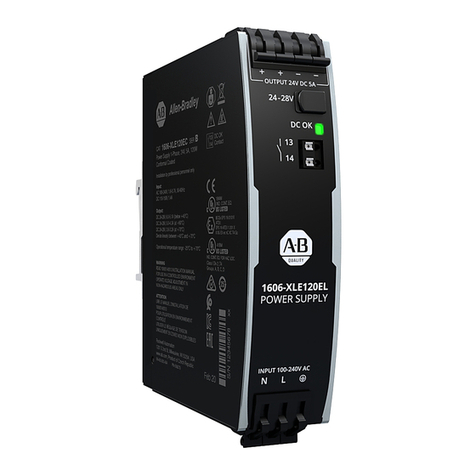
Rockwell Automation
Rockwell Automation Allen-Bradley 1606-XLE120EL installation instructions
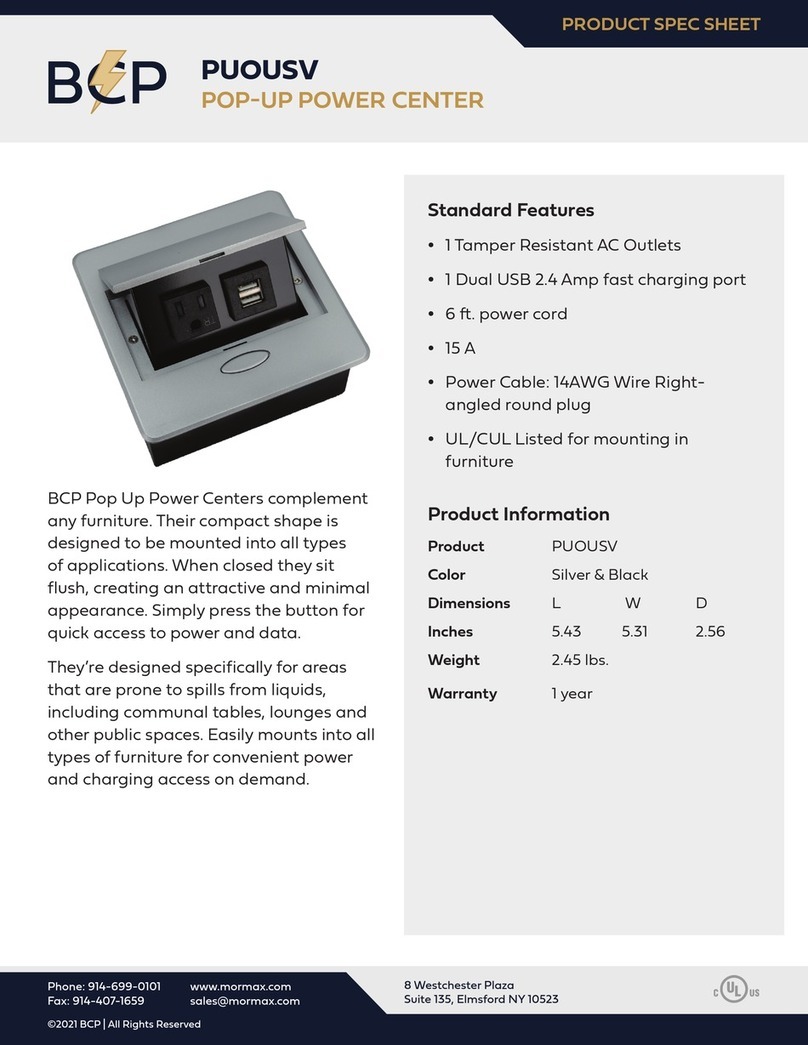
BCP
BCP PUOUSV How to install

Sophos
Sophos XRP 2000 Mounting instructions
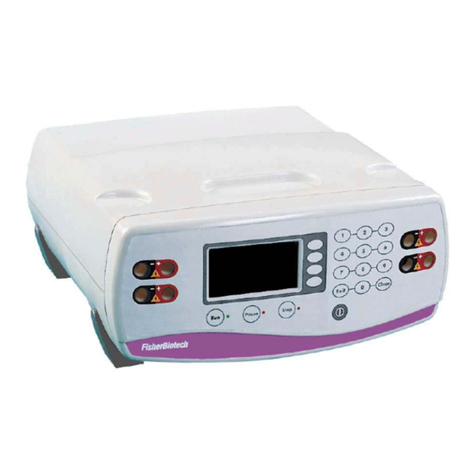
Fisher Scientific
Fisher Scientific FB1000-2 Operator's manual
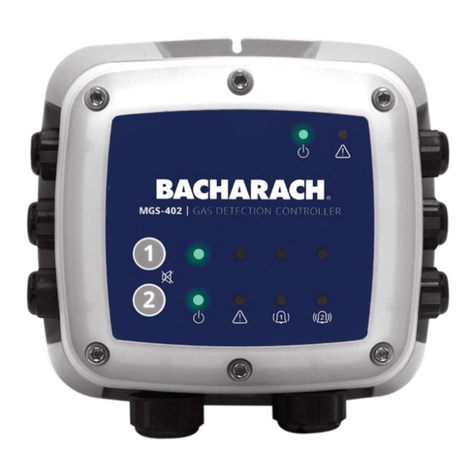
Bacharach
Bacharach MGS-402 24V Product bulletin

Bresser
Bresser PSW 300 instruction manual


